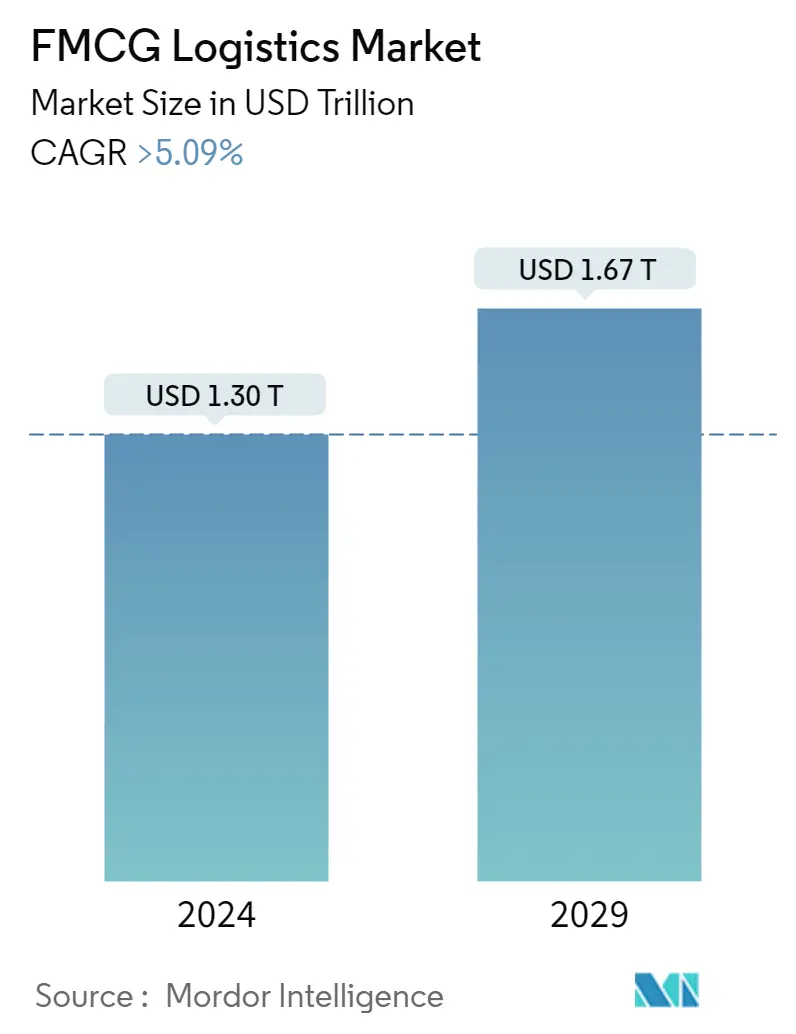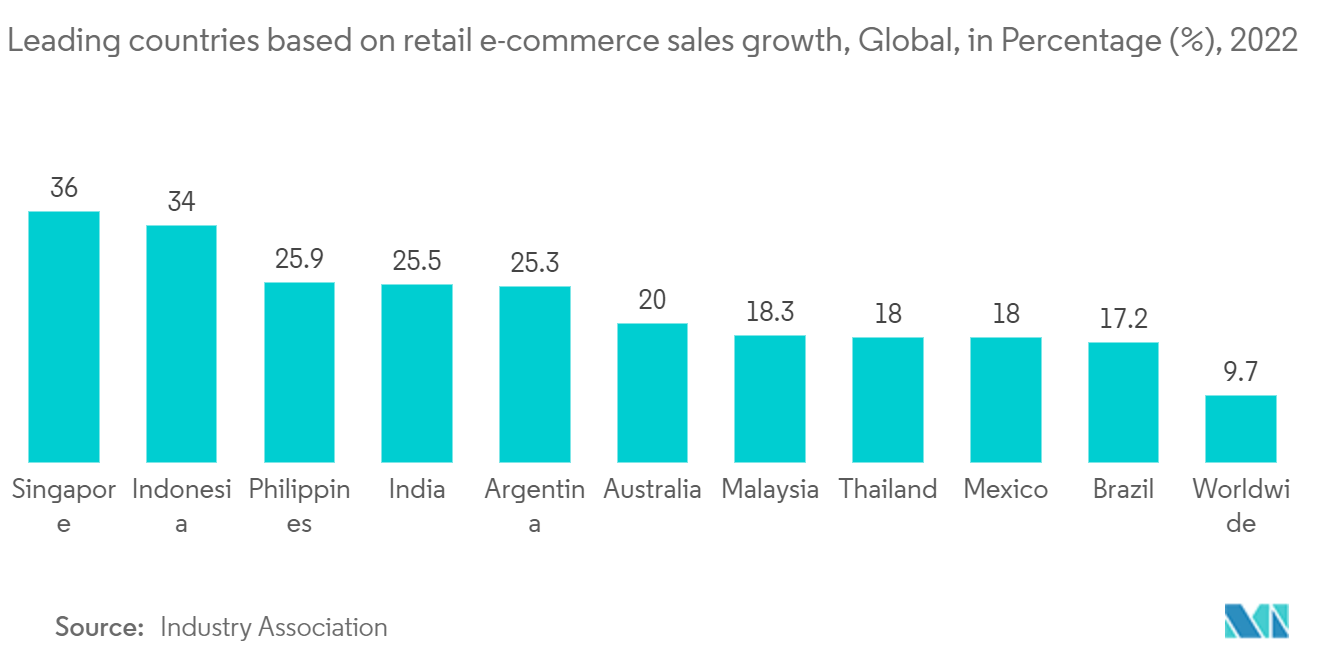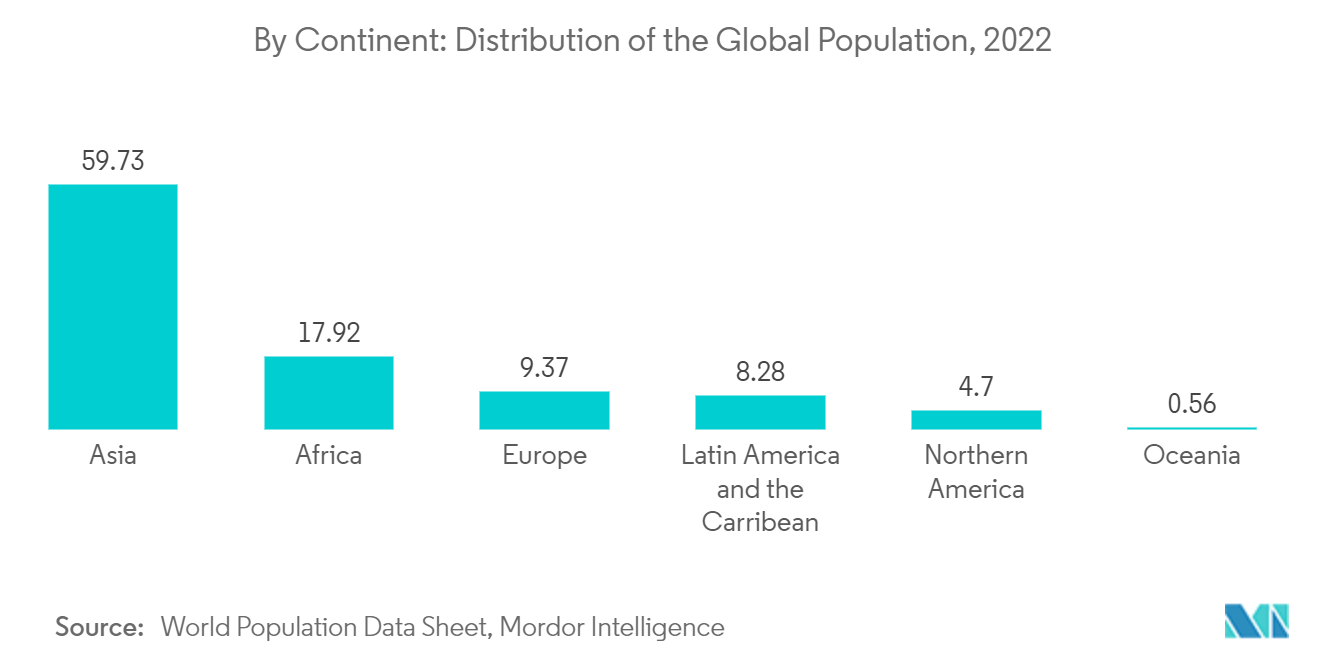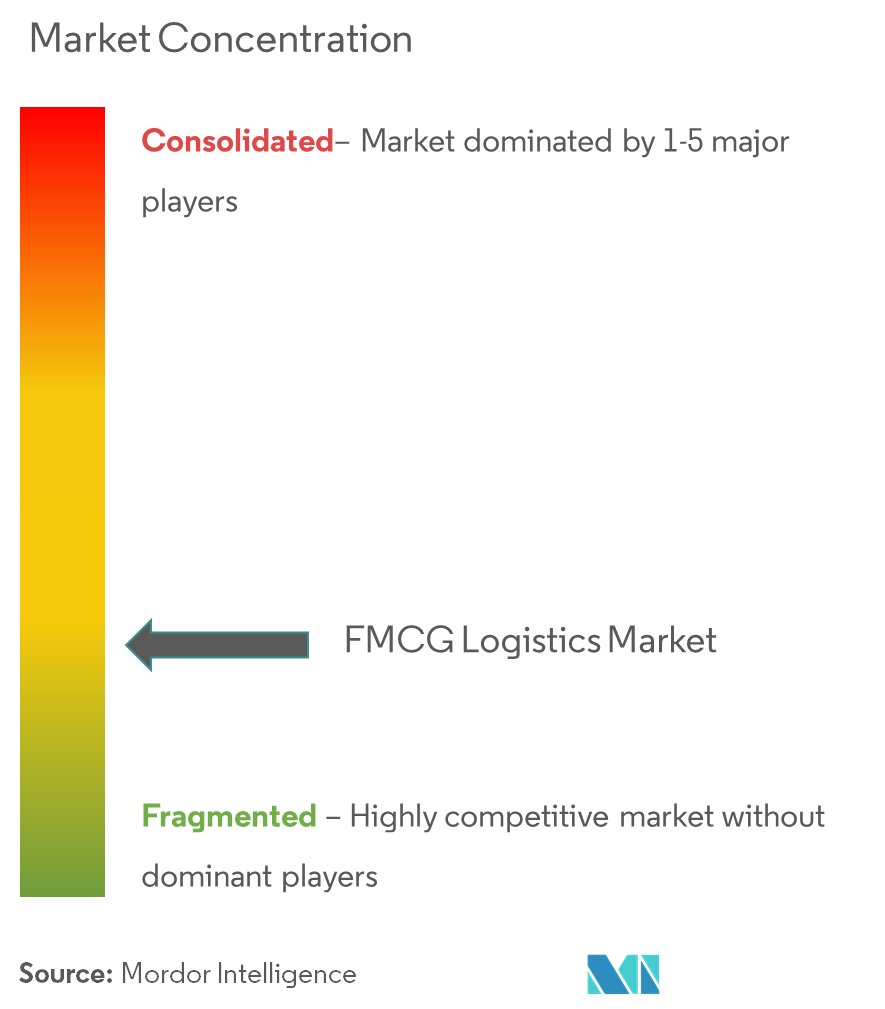FMCG Logistics Market Size

| Study Period | 2019 - 2029 |
| Market Size (2024) | USD 1.30 Trillion |
| Market Size (2029) | USD 1.67 Trillion |
| CAGR (2024 - 2029) | 5.09 % |
| Fastest Growing Market | Asia Pacific |
| Largest Market | North America |
Major Players
*Disclaimer: Major Players sorted in no particular order |
FMCG Logistics Market Analysis
The FMCG Logistics Market size is estimated at USD 1.30 trillion in 2024, and is expected to reach USD 1.67 trillion by 2029, growing at a CAGR of greater than 5.09% during the forecast period (2024-2029).
- FMCG is considered a unique business model that requires competitive advantages in manufacturing, branding, advertising, and logistics. The key growth drivers for the consumer goods industry are changing lifestyles, ease of access, and rapidly changing consumer habits. Consumers expect a wide array of products to be always available in local stores and online. to achieve this, consumer goods companies tie up with global supply chains that are highly efficient, agile, and sustainable. FMCG manufacturers are adopting collaborative logistics solutions that deliver products to stores faster and more cost-effectively. The recent e-commerce boom has also been a blessing for the FMCG industry.
- From traditional storekeeping, purchasing, materials management, and integrated materials management, the industry is entering a new era of supply chain management. The logistics operations in FMCG businesses are typically operated on a hub-and-spoke model type with distribution hubs in major towns and cities serving both the wholesalers and retailers. Consumers are expecting fast order fulfilment through multiple channels. To make this possible, consumer goods companies outsource their logistics operations to bridge the gap between sales planning and operational processes, improve forecasting, streamline inventory, and speed up delivery times.
- FMCG players are expected to rely more on logistics service providers (LSPs) to meet demand from new consumption patterns. Investment in supply chain automation, expansion of existing manufacturing facilities, and the emergence of warehouse hubs are essential areas of focus in the current market study. Distribution facilities and locations, along with a strong supply chain strategy, will play a critical role in the success of FMCG operators soon. To maintain a better competitive position and access key demand demographics, businesses will need to consider the location strategically to meet the growing demand.
FMCG Logistics Market Trends
Growing Penetration of E-commerce Demands Efficient Logistics Operations
E-commerce is reshaping the global retail market. Till date, the e-commerce boom has favored the travel sector, as well as apparel and electronics retailers. E-commerce currently contributes less than 7% of the global fast-moving consumer goods (FMCG) market. One of the key reasons for the slower uptake of online FMCG has been the logistical challenges associated with ensuring fresh and perishable products arrive at the consumer in top condition. Additionally, in advanced markets, especially those with dense populations such as Germany, many FMCG products are readily available in close proximity to consumers at brick-and-mortar stores.
However, with increasing consumer demand for convenience, and better technology and other enabling conditions, online FMCG growth is accelerating across the globe. FMCG online growth will continue to outpace offline growth, and most retailers and manufacturers need Omnichannel strategies to ensure future success. Online FMCG sales are set to double globally over the next few years and will grow twice as fast in developing markets than in developed markets. The Asia region is expected to provide some of the biggest growth opportunities for online FMCG over the next five years.
The current online marketplace offers visibility of inventory status and expected delivery time and a variety of shipping options including free tracking options and easy returns. To provide free shipping, retailers need to get low-cost solutions from their logistics providers. Equally, to propose fast, including same-day delivery options to their consumers, retailers need high-priority and entirely reliable logistics services.

The rising population driving the expansion of the FMCG Industry
The growing population is one of the key reasons driving the expansion of the global FMCG industry. In actuality, the quick expansion in population is inversely correlated with the rise in consumer goods consumption. Similar factors include regular product launches, increased consumer awareness of various FMCG products, rising middle-class disposable incomes, easier access to consumer goods, a noticeable shift in consumers' lifestyles in developed and developing nations, strong brand advertising, and attractive price points, strong logistics and distribution channels of such companies, expansion of online commerce, and increased R&D spending by both established players and newcomers in the market.
Also, the increasing use of social media and the internet has created a wealth of development prospects in the past and is certain to do so in the future. As one of their primary methods to capture a sizeable portion of the market, several top international businesses in the industry are dedicated to offering consumers personalized solutions. A few of these tactics involve product introductions and acquisitions.
Consumers nowadays are increasingly looking for convenience, healthier alternatives, and locally produced organic products. This demand for ease was what gave rise to eCommerce, which has flourished. Companies are making significant investments in digital analytics, and many think that among all consumer industries, the retail sector is perhaps the ripest for transformation.

FMCG Logistics Industry Overview
The FMCG logistics market is fairly fragmented with the presence of large players and small and medium-sized local players with quite a few players who occupy the market share. DHL Group, C.H. Robinson, Kuehne + Nagel, Ceva Logistics, DB Schenker, DSV, and XPO Logistics are among Global’s top competitors. Most of the global logistics players have a retail and consumer goods logistics division to meet the market needs and demand. Additionally, local players are increasingly enhancing their capabilities in terms of inventory handling, service offerings, products handled, and technology.
FMCG Logistics Market Leaders
-
DHL Group
-
Kuehne + Nagel
-
C.H. Robinson
-
Ceva Logistics
-
FedEx Corporation
*Disclaimer: Major Players sorted in no particular order

FMCG Logistics Market News
- August 2023: Reliance Retail expanded its store count by 3,300 reaching a total of 18,040 stores with a combined area of 65.6 million square feet.
- July 2023: India's Swiggy is set to acquire LYNK Logistics, a retail distribution company in the fast-moving consumer goods (FMCG) space, marking the food-delivery company's entry into the retail business-to-business (B2B) segment. The acquisition of LYNK will help Swiggy strengthen its food and grocery delivery network via an extensive retail distribution system.
FMCG Logistics Market Report - Table of Contents
1. INTRODUCTION
- 1.1 Study Deliverables
- 1.2 Study Assumptions
- 1.3 Scope of the Study
2. RESEARCH METHODOLOGY
- 2.1 Analysis Methodology
- 2.2 Research Phases
3. EXECUTIVE SUMMARY
4. MARKET OVERVIEW
- 4.1 Current Market Scenario
-
4.2 Market Dynamics
- 4.2.1 Drivers
- 4.2.1.1 Rising consumer demand for fast and efficient delivery
- 4.2.1.2 The need for streamlined supply chain operations
- 4.2.2 Restraints
- 4.2.2.1 High trasnportation costs
- 4.2.2.2 Complexity of managing perishable goods
- 4.2.3 Opportunities
- 4.2.3.1 The adoption of advanced technologies
- 4.2.3.2 Expansion of e-commerce platforms
-
4.3 Industry Attractiveness - Porter's Five Forces Analysis
- 4.3.1 Threat of New Entrants
- 4.3.2 Bargaining Power of Buyers/Consumers
- 4.3.3 Bargaining Power of Suppliers
- 4.3.4 Threat of Substitute Products
- 4.3.5 Intensity of Competitive Rivalry
- 4.4 Industry Value Chain Analysis
- 4.5 Government Regulations and Initiatives
- 4.6 Global Logistics Sector (Overview, LPI Scores, Key Freight Statistics, etc.)
- 4.7 Focus on Global FMCG Industry (Overview, Distribution Channels, Major Product Categories, etc.)
- 4.8 Spotlight - Effect of E-commerce on Traditonal FMCG Logistics Supply Chain
- 4.9 Effect of FMCG Retail Sector's Fast Replenishment Cycles on the Logistics Market
- 4.10 Spotlight on the Demand for Contract Logistics and Integrated Logistics*
5. MARKET SEGMENTATION
-
5.1 By Service
- 5.1.1 Transportation
- 5.1.2 Warehousing, Distribution, and Inventory Management
- 5.1.3 Other Value-added Services
-
5.2 By Product Category
- 5.2.1 Food and Beverage
- 5.2.2 Personal Care
- 5.2.3 Household Care
- 5.2.4 Other Consumables
-
5.3 Geography
- 5.3.1 Asia-Pacific
- 5.3.2 North America
- 5.3.3 Europe
- 5.3.4 Latin America
- 5.3.5 Middle East and Africa
6. COMPETITIVE LANDSCAPE
- 6.1 Overview (Market Concentration, Major Players)
-
6.2 Company Profiles
- 6.2.1 DHL Group
- 6.2.2 C.H. Robinson
- 6.2.3 Kuehne + Nagel
- 6.2.4 Ceva Logistics
- 6.2.5 XPO Logistics
- 6.2.6 DB Schenker
- 6.2.7 Hellmann Worlwide Logistics
- 6.2.8 DSV
- 6.2.9 Bollore Logistics
- 6.2.10 Rhenus Logistics
- 6.2.11 FM Logistic
- 6.2.12 Kenco Logistics
- 6.2.13 Penske Logistics*
- *List Not Exhaustive
- 6.3 Other Companies
7. FUTURE OF THE MARKET
8. APPENDIX
- 8.1 GDP Distribution, by Activity-Key Countries
- 8.2 FMCG Retail Statistics
- 8.3 Economic Statistics Transport and Storage Sector, Contribution to Economy (Key Countries)
- 8.4 Global Consumer Goods Flow Statistics
FMCG Logistics Industry Segmentation
FMCG logistics management is concerned with the efficiency and effectiveness with which daily activities involving the transportation of daily usable goods from one location to another are managed. It is the management of the flow of goods from one point of origin to another to meet the needs of customers.
A complete background analysis of the FMCG Logistics Market, including the assessment of the economy and contribution of sectors in the economy, market overview, market size estimation for key segments, and emerging trends in the market segments, market dynamics, and geographical trends, and COVID-19 impact is included in the report.
The FMCG logistics market is segmented by service (transportation, warehousing, distribution, inventory management, and other value-added services), and by geography (Asia-Pacific, North America, Europe, Latin America, Middle East and Africa). The report offers market size and forecasts in value (USD) for all the above segments.
| By Service | Transportation |
| Warehousing, Distribution, and Inventory Management | |
| Other Value-added Services | |
| By Product Category | Food and Beverage |
| Personal Care | |
| Household Care | |
| Other Consumables | |
| Geography | Asia-Pacific |
| North America | |
| Europe | |
| Latin America | |
| Middle East and Africa |
FMCG Logistics Market Research FAQs
How big is the FMCG Logistics Market?
The FMCG Logistics Market size is expected to reach USD 1.30 trillion in 2024 and grow at a CAGR of greater than 5.09% to reach USD 1.67 trillion by 2029.
What is the current FMCG Logistics Market size?
In 2024, the FMCG Logistics Market size is expected to reach USD 1.30 trillion.
Who are the key players in FMCG Logistics Market?
DHL Group, Kuehne + Nagel, C.H. Robinson, Ceva Logistics and FedEx Corporation are the major companies operating in the FMCG Logistics Market.
Which is the fastest growing region in FMCG Logistics Market?
Asia Pacific is estimated to grow at the highest CAGR over the forecast period (2024-2029).
Which region has the biggest share in FMCG Logistics Market?
In 2024, the North America accounts for the largest market share in FMCG Logistics Market.
What years does this FMCG Logistics Market cover, and what was the market size in 2023?
In 2023, the FMCG Logistics Market size was estimated at USD 1.24 trillion. The report covers the FMCG Logistics Market historical market size for years: 2019, 2020, 2021, 2022 and 2023. The report also forecasts the FMCG Logistics Market size for years: 2024, 2025, 2026, 2027, 2028 and 2029.
FMCG Logistics Industry Report
Statistics for the 2024 FMCG Logistics market share, size and revenue growth rate, created by Mordor Intelligence™ Industry Reports. FMCG Logistics analysis includes a market forecast outlook to 2029 and historical overview. Get a sample of this industry analysis as a free report PDF download.



